#write an example function in function name() format and then write the same function but in arrow format.... girl cmon
Explore tagged Tumblr posts
Note
Hello, new to interacting with the fandom tbh. It's been a few years (1 year and a couple of months) since I've seen miraculous. Why did s4 and s5 so cluttered? Sentimonster Felix and Adrien? Shouldn't that complicate things? I mean, they're created with magic. And Kagami and Felix? After he kidnapped her and stole all of the miraculous to give it to Hawkmoth? He's even worse than Chloe, why did they make him into a hero? Like he should have been an anti-hero at best. And why Catwalker? Why all of the lovesquare shenanigans? It's so confusing. And did they seriously replace Chloe with Zoe (gosh even their names sound the same)? Half-sister? Who wasn't even there in episodes with Audrey? Zoe from New York, a better sister than Chloe with a heart of a hero? Am I reading a fanfic? And why did they make Alya and Zoe into ladynoir's replacement if Ladybug and Chat Noir are coming back anyway? What is this mess?? And did they seriously make Chloe into a mayoress? Uh hello? She's a minor? Minors aren't allowed in any government offices no matter their age or status. What happened to this show?? The early seasons were already cluttered in its writing but at least they're at least understandable. But what the heck is s4-s5? Heck even the powers of some of the kwamis don't make sense.
I obviously can't give you the real logic for why all of this happened since I'm not one of the show's writers, but I can give you my best guess based on what we know about the show. In my opinion, all of this nonsense happened because of poor planning and bad writing both of which were compounded by the fact that Miraculous is an episodic formula show where every episode is supposed to be able to stand alone as its own self-contained story.
This is not a bad thing in and of itself. There are many successful properties that use this format. The problem is that it's a terrible format for everything that Miraculous is trying to do because this format means that nothing can be properly developed. As an example from your list, Felix can't be a complex character who requires multiple episodes to properly understand. He has to be straight-forward enough that I can catch a random episode and understand who he is in that episode even if it massively contradicts other episodes. That's why his "redemption" is so wacky and nonsensical. It's not a coherent narrative. It's a highlight reel of the big moments in a narrative we never get to see in full because that would require some level of serialization.
This is the answer to basically everything you listed. For example, why did season five start with all of those awkward lovesquare shenanigans? Those happened because the square can't have a functional arc where the they get together as that would require a storyline that goes over multiple episodes, but the writers still wanted to make them getting together dramatic, so we get a disjointed mess of shenanigans where Ladynoir gets married in one episode, the crushes flip in the next episode, and Marinette is #Thirsty for Chat Noir in the episode after that even though it completely contradicts Marinette's emotional state in the crush flip episode (she wasn't #Thirsty, she was #Horrified!)
We don't even see the square actually get together! Kwamis' Choice gives us these two moments:
Alya: How did we go from “I’m pathetic and I’ll never love again” to “Yay! I’m going out with Adrien”? Marinette: I’m not going out with Adrien…
and
(Marinette attempts to reach out and hold Adrien's hand but shakes as she is a few inches away from his hand. She attempts to do it again, but this time forcibly reaching for his hand.) Adrien: Are you okay, Marinette? If you're not ready, you don't have to. Marinette: (while struggling to reach out for Adrien's hand) No! I can... do this!! (grunts aggressively) Adrien: You know, we can just be friends if you prefer. Marinette: No! No, I don't want to be friends with you! Adrien: (taken aback and gasps) I see... Marinette: No! I didn't mean it like that! Ugh, my hand... will obey me!!
And then the very next episode opens with Chat Noir and Ladybug telling each other about their new relationships:
Cat Noir: I'm super happy for you, m'lady. Can you believe it? I have a girlfriend, you have a boyfriend, and we can talk about it! Ladybug: Like real friends. Ladybug and Cat Noir: It's awesome. Pound it!
Which makes no sense because when did the relationship happen???? I thought you two weren't dating yet??? What is going on here???
The only answer I can come up with is what I said above: the writers need each episode to be self contained, but they also wanted the square getting together to be dramatic and have some semblance of an actual plot-line, so they tried to do both of those things by giving us a highlight reel instead of a coherent narrative. Does it work? Not really, but that's why a multi-episode romance plot is a terrible choice for an episodic formula show that vows to have each episode truly stand alone. There is a reason I keep pointing out that Kim Possible got its endgame couple together in an hour-long special that didn't follow the show's standard formula. That's about the only way to do it right while maintaining your status as an episodic formula show.
Pick a plot/plot point from your list and ask yourself: can I tell this properly in a self-contained 20 minute episode while also including an akuma fight? If the answer is no, then that's your answer for why it's bad. It's also the answer for why there's so much crap in seasons four and five. The writers are trying to advance their season-specific plot and their multi-season plot in disjointed chunks while also keeping the audience engaged. This led them to add in tons of random shit that will never be properly addressed, but that makes for solid cheap drama because, once again, everything the show gives us needs to be done in self-contained 20 minute stories that also include an akuma fight.
This is also why Marinette never tried to rescue the Kwamis. That would require her to be able to track down where they are and she couldn't succeed in doing that until the final. She also couldn't make slow progress throughout the season because that's too serialized. Because of those limitations, Marinette spends the season being cringe over Adrien because that doesn't need a ton of additional context for a viewer to understand what's going on. A line or two at the start of the episode tells you the current status quo even if that status quo doesn't feel like it makes much sense for the characters from the perspective of the ongoing narrative.
An example of this is Marinette going from crying over her crush on Chat Noir in Determination to being happy about her crush in Passion. Her being upset is way too complicated to explain and resolve, so instead we get this:
Alya: What do you mean you're in love with Chat Noir? Marinette: I don't see what's so weird about it. Alya: It's weird, because you were in love with Adrien just, like, yesterday. (points at the corkboard with photos on the wall next to them) Marinette:(covers the corkboard with her body) Adrien? Yeah, but being in love with Adrien was not a good idea.
I don't like any of this, but it is what it is. Expect more of the same in season six
47 notes
·
View notes
Note
can i inquire generally what your twine stories look like in editing format? like with the different connected squares that contain text blocks. im writing smth rn but i fear my organization in twine is not optimal at all. how did you manage for as big of a story as you have?
I figured out something that makes sense to me. I'm the only person developing this game, so it's optimized for my own systems and workflow. What I do may not work for anyone else.
A few things: I don't try to pre-plan my branches in Twine itself. It doesn't really matter what the tree even looks like until I'm coding it, and the main thing the visual editor helps with is seeing the overall flow of the game, how everything connects together, and finding sections where something got overlooked.
Because of the lag in the Twine editor and also to help with compartmentalizing the game into different sections, I split it into multiple stories that are then compiled with Tweego. So, there is no overarching editing tree for the whole game that I actually use.
This post and this post goes more into that process.

This is my current library, with each chapter file labelled. WAYFARER is the start of the game (CC, Prologue, the first bit of Episode 1), Chapter_1.1 is the Route A Count fight and end of the episode, Chapter_1.2 through to Chapter_1.6 is Route B of Episode 1, Chapter_2.1 to Chapter_2.3 is Episode 2, so on and so forth).

This is what one of the files in the editor looks like. I colour code some passages to make it easier to see major events (yellow is autosave, green is the start of a major branch/choice, red is combat). This story file corresponds to the fight with the Crimson Count on Route B in Episode 1.
I use an old version of the Twine editor because I didn't like some of the newer updates, so I reverted to the last version I like (that's why my library and story files may look a bit different from what's current).
I don't use VSCode with Twee plugins since I didn't like it, though that is probably a better way to make a large game than what I'm doing. I have a system that works for me; I don't really see the point in updating it to something else when what I do makes a functioning game and I already have a lot on my plate with writing new content.
I've heard of people taking Wayfarer's HTML file and attempting to upload it into the Twine editor to code dive, but this is not going to be useful because:
The size of the compiled game will make the editor non-functional due to lag. It will probably break it.
Twine overlays all of the compiled story files on top of the other so you can't even see what's going on.
What is helpful for me is to make sure that every passage has a unique label. I never name my passages the same thing as their link text (for example, if I have a link that reads "1. Attack", the title of the corresponding passage is never "1. Attack").
Instead, I label passages according to what story file they are in along with a single word referencing my internal notes so I don't get lost, and then a letter + number combination for tracking splits. So, a link that reads as "1. Attack" to the player may end up having a passage title as something like CHAPTER 3.4 ATTACK 01. And then if it divides into three choices at the end of the passage, the titles for those passages could end up as something like CHAPTER 3.4 ATTACK 01A, CHAPTER 3.4 ATTACK 01B, CHAPTER 3.4 ATTACK 01C.
24 notes
·
View notes
Text
Glucosify's Quick Start Guide to Twine's Sugarcube for Interactive Fiction
Or GQSGTSIF for short.
Very simplified guide to making interactive fiction on Twine, using Sugarcube. This won't cover how to change the UI or anything like that, it's really the bare bones on how to make passages, variables, choices etc. There are multiple ways and syntaxes to do these things, I'm covering the ones I use but it's really not the only way to write code and to do these things ^^ This is not a replacement to the documentation, I'll link relevant parts of the documentations throughout the guide but it's really going to be your best source of information Let me know if there's anything else you think I should add in there ~ 1. Passages & StoryInit 2. Variables 3. If statements 4. StoryMenu (bonus)
First of all, assuming you've already downloaded Twine and opened a new project, make sure that your default story format is Sugarcube (in the top left of the window, go to Twine -> Story Formats and click on Sugarcube then at the top left 'use as default format')

Now, go back to your project. In the top left, click on Passage -> New : this is how you'll create new passages.

Passages are what makes the game essentially, it's where you write your story. Whenever you play an if and you click on a choice and it progresses to a new passage of text, that's how it's done. Make sure to name your passages in a way that makes sense to you, two passages can't have the same name. It's probably best the names aren't super long either considering the names are what you'll type in your code to make the player go to this or that passage.
Special passages :
there are some passages that have special functions. Create a passage and name it StoryInit : this passage is used to store variables. Whenever a new game is started, it will load up the variables states as they are in the StoryInit passage. This is essentially a default state where no progress has been made in the story so for example : all stats would be at 0, all relationships points would be at 0, the MC wouldn't have a name yet etc. We'll store our variables there. Variables are attached to values, these values change as the player goes through the story. A variable's value can be many things, it could be a string which is anything that you'd write inside double quotes "" and would be printed as is in the string. For example :
<<set $mcName to "">>
$mcName is a variable. Its value changes to whatever the player chooses for the MC name. As you write your code, you just have to type $mcName and it will be changed to whatever name the player has set it to. A variable's value can also be a number, in this case, you wouldn't write it in double quotes.
<<set $confidence to 50, $maxConfidence to 100>>
It can also be a true or false statement.
<<set $IrisRomance to false>>
Figure out what needs to be a variable in your story and add them accordingly in your StoryInit passage, you'll add more variables as you go. Remember to give them a value, even if the value is 0 or "". Common variables would be for the MC's name and different physical traits, personality stats, pronouns, character's relationships stats etc. For this tutorial, write in your StoryInit :
<<set $mcName to "">>

Now, let's test our variable. Create another passage, call it start. In the top left bar, select Start Story Here : you should now see a little green rocket attached to your start passage. This is the passage the players will first see when they launch your game.

Inside the "start" passage, let's make a way to enter your own name with a simple text box.
<<textbox "$mcName" "Enter your name">>
Under it but still inside the "start" passage, let's write a simple link that will let us go to the next passage when we click on it.
<<link 'click here to confirm your name' 'next'>><</link>>
((the first string in the single quote is what will be displayed on the screen as the link, the second word in quotes, in this case 'next' is the name of the passage this link should direct you to))
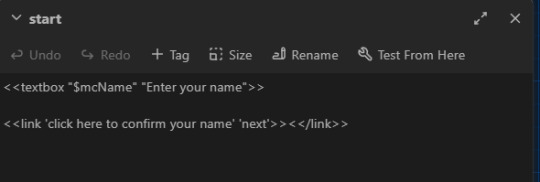
Now make a second passage and call it next. Inside that passage, write this :
My name is $mcName.
Let's see if it works : in the top left, go to build -> play.

It will open an html file in your default browser. Considering we haven't touched the UI, it will have the default Sugarcube UI. You should have a textbox on the screen and a link under it in blue. If your link is red or if you have an error, go back to your code and check for misspellings or make sure you have the right amount of quotes etc.

Type whatever name you want inside that text box then click on the 'click here to confirm your name' link. It should now have changed the $mcName we wrote in the next passage into the name you input in the box. Congrats, you've learned how to set, change and display a variable :^) Now, let's say you want personality (or relationship) stats that change when you select a choice. Back in your StoryInit :
<<set $confidence to 50, $maxConfidence to 100>>
If you want to have a visual elements like actual bars and meters, I would suggest making it easy on you and just getting Chapel's meter macro. You just copy the minified code inside your Javascript file (top left -> story -> Javascript) and then write in your StoryInit and in your relationships / stats / profile page as explained on his demo. Go back to your "next" passage. Under the first sentence, let's write two choices link, one that will lead to an increase in confidence and one that lowers it.
<<link 'You are not confident. Life is hard.' 'sadface'>><<set $confidence to Math.clamp($confidence - 10, 0, $maxConfidence)>><</link>> <<link 'You are very confident. Life is great.' 'happyface'>><<set $confidence to Math.clamp($confidence + 10, 0, $maxConfidence)>><</link>>
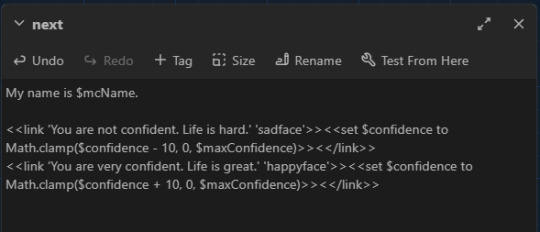
((Math.clamp might look intimidating but don't worry too much, it's just to make sure your variable's value doesn't go over the min and max allowed so you can't go below 0 or above 100 in this case. You write the variable you want to change then a + or a - followed by how many points you want to remove / add - in this case, 10. Then the 0 is the minimum and the $maxConfidence is the maximum value.))
Now create two new passages, one called sadface and one called happyface. To make sure your variable changed, type $confidence in both of the new passages and play your game.
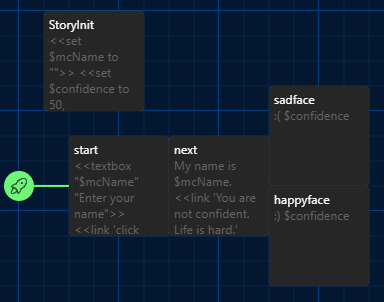
On one of the statement, it should now say 40 instead of 50 and 60 in the other one. Congrats you've learned how to change a stat. :^)
But what if you want two choices to lead to the same passage but to display different informations depending on how high / low a stat is? Welcome to the world of if statements. Back in StoryInit, you know the drill :
<<set $idiotLove to 0, $idiotMaxLove to 100>> <<set $idiotRomance to false>>
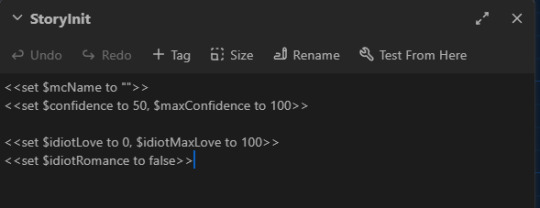
New passage, call it LoveCheck. Go back to your "next" passage :
<<link 'Click here to get 25 love points with the idiot.' 'LoveCheck'>><<set $idiotLove to Math.clamp($idiotLove + 25, 0, $idiotMaxLove)>><</link>> <<link 'Click here to get 50 love points with the idiot.' 'LoveCheck'>><<set $idiotLove to Math.clamp($idiotLove + 50, 0, $idiotMaxLove)>><</link>> <<link 'Click here to get 100 love points with the idiot.' 'LoveCheck'>><<set $idiotLove to Math.clamp($idiotLove + 100, 0, $idiotMaxLove)>><</link>> <<link 'I\'m allergic to idiots.' 'LoveCheck'>><</link>>
((you need to add a \ before your apostrophe when it's supposed to be part of the string, otherwise, the program will just think that's a closing single quote and not an apostrophe))
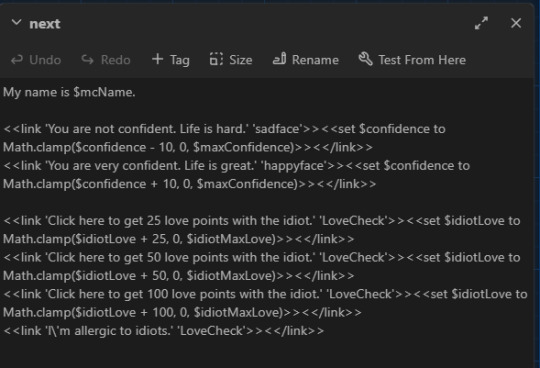
Alright, so now go to your newly created LoveCheck passage and let's write your first if statement. An if statement is basically a condition that you set, if the statement is 'valid' so like if it's a match then the program will ignore every other 'if' possibility. This is important because it means the order of your if statements matters. An if statement can be as simple as :
You are a person. <<if $idiotRomance is false>>You are not in love with an idiot.<</if>>
((this means that if the variable is false, then the second sentence will be displayed but if the variable is true, then the second sentence wouldn't be displayed to the player.)) An if statement can have an else :
You are a person. <<if $idiotRomance is false>>You are not in love with an idiot. <<else>> You love an idiot, I'm sorry. <</if>>
Note that this is the same as this, using elseif :
You are a person. <<if $idiotRomance is false>>You are not in love with an idiot. <<elseif $idiotRomance is true>> You love an idiot, I'm sorry. <</if>>
What this does is, if the variable is true, it will show the third sentence and not the second one and vice versa if the variable is false - because an if statement will only display the first statement that matches, if the variable is true then it will ignore any statement that require the variable to be false. As I said earlier, the order of your statement matter especially with variables tied to numerical values. You'll understand better once you try it - let's do it in the wrong order first (still in your LoveCheck passage), we'll print the $idiotLove variable to see its value :
$idiotLove <<if $idiotLove gte 25>> You like the idiot a little. <<elseif $idiotLove gte 50>>You like the idiot quite a bit. <<elseif $idiotLove gte 100>>You've fallen for the idiot, it's too late to save you. <<else>> You don't even know who the idiot is, good for you.<</if>>
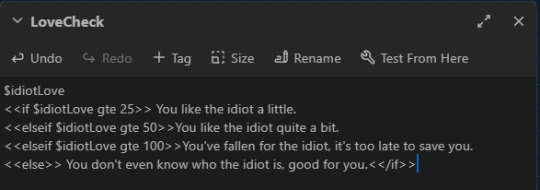
Click play and let's look at the problem. If you click on all the links, the number will be different but the sentence will still say that you like the idiot a little, even if you have 100 points. That's because gte stands for greater than or equal to, 100 is greater than 25 so the first statement is always valid so long as you have at least 25 points. The program sees the first statement matches and is valid so it has no need to read the rest of the if statements. To remedy this, we just change the order :
$idiotLove <<if $idiotLove gte 100>>You've fallen for the idiot, it's too late to save you. <<elseif $idiotLove gte 50>>You like the idiot quite a bit. <<elseif $idiotLove gte 25>>You like the idiot a little. <<else>> You don't even know who the idiot is, good for you.<</if>>
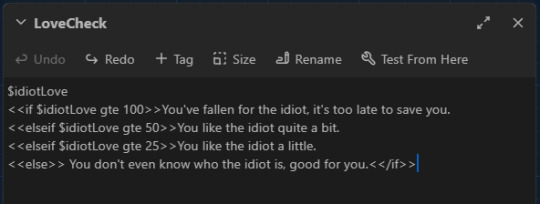
Now it works. If statements will be your most used tool I imagine, especially if there's a lot of variations in your story. You can use if statements for pronouns, for stat checks, romance checks etc.
I can always make another guide for the UI but for now, I'll just show you how to add another link in the sidebar of the default UI, using StoryMenu.
Make a new passage, call it StoryMenu :
<<link 'relationships' 'relationships'>><</link>> <<link 'stats' 'stats'>><</link>>
Make two new passages called relationships and stats. Write whatever you want in them, if you're using Chapel's meters, you could use the <<showmeter>> macro here to display your stat bars.
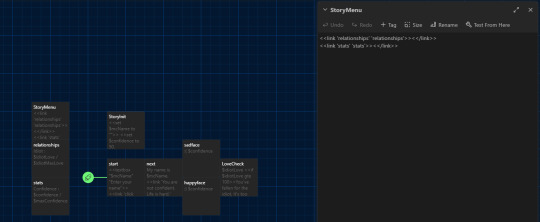
#did this in a couple of hours so it's nothing fancy#twine#coding in twine#twine sugarcube#interactive fiction#hope it helps the person who messaged me about needing help with sugarcube
102 notes
·
View notes
Text
MY RANT ABOUT LEVEL 5 SHITY WRITING OF WOMAN.
Part one: Haruna Otonashi
Alright, I will start this by saying this will be a small series. I will talk about the managers in a pretty random format, but I just need to get it off.
Haruna is introduced as Raimon’s team manager, and right from the start, she has this great personality, she’s confident, supportive, and is well informed, perfect combo. She’s not your typical “cheerleader” or just a background female character; she actually brings a grounded vibe to team and we know that she is also used to push the storyline when they needed to intrideced new teams.
That's about it from the positives.
Haruna had all the ingredients to be a standout character in her own right, without her brother, and without this "quirky personality" she has. Despite all that, the writing barely gave her anything meaningful to do. She mostly floats around in the background, cheering the boys on and occasionally stepping in to provide advice or moral support, but she never really gets her own moments or development.
Haruna and Kidou sibling relationship is so frustrating. Not because their dynamic is bad, but because Haruna’s character is mostly used as a tool to make Kidou look like a more complex, "strong” character. Kidou’s internal struggles and emotional depth get a lot of focus, which is great for him, but that often comes at the expense of Haruna’s own development. Instead of being portrayed as her own capable person, Haruna mostly exists to support Kidou’s story, reinforcing the idea that her significance revolves around him. Whenever she has any moments it' ususaly somehow related to her brother.
Throughout the series, Haruna is shown as this tough, confident manager, but the moment the story zooms in on Kidou’s emotional moments, she fades into the background or is framed as someone who can’t really function without her brother. It creates this weird imbalance where Kidou’s character growth is front and center, while Haruna is reduced to a side character whose value is measured by how she fits into Kidou’s narrative.
What’s worse is that this dynamic makes Haruna feel almost useless without Kidou, which isn’t fair to her character at all. She’s clearly competent and important as Raimon’s manager, but the writing rarely acknowledges her strengths outside of her connection to Kidou. It’s a real shame because both characters could have been given fully realized arcs that explore their sibling bond and their individual growth. Instead, Haruna ends up mostly serving as emotional support for Kidou, which really undercuts her potential. The best example ? For Kindou we got a whole arc about his family life, and how he tried so hard to be with his sister. And Haruna? WE KNOW SHIT. All we know is that she changed her last name and her new family is nice. That's it.
Now some people might say "Oh but when they met kogure and she reflected on how much she changed. That wasn't about Kindoi, " that was
a) only one-time thing. And B) IT WAS RELATED TO HER BROTHER AND KOGURE!
HARUNA WAS USED TO MAKE KOGURE LOOK BETTER. And don't get me wrong, it's a fun storyline, but she didn't get anything from it. The only thing she got was a funny "side kick" if you will. That's funny to watch and is useful to make Kogure look funnier.
Now I'm also gonna talk about her relathionship with Tachimukai. Cause while it has the same problems as her relationship with Kogure, in my opinion, it's a bit more interesting. It shows she kind of grew, she listed, and it showed us a part of her that we didn't know. A caring hard working mannager. AND THEY COULDHAVE EXPLORED THAT FURTHER!! It would also be a great way to talk about tachimukai insecurities, they couldhave gave Tsunami a Saver complex and how haruna would help him too. Instead, she’s kind of stuck as “the smart manager,” a role that’s so underused and undervalued in the series.
And it’s a bummer because female characters like her are rare in Inazuma Eleven, especially ones who are tough and confident but not reduced to just love interests (i mean we have Kira Hitomiko? But she is empty, we have Touko but she is just a tomboy stereotype) Haruna could have broken the mold — but instead, she got stuck in the sidelines, literally and figuratively.
Honestly, the writing just didn’t give her the space to shine or develop. She had so much potential to be a more dynamic, complex character and an essential part of Raimon’s story — but instead, we got another "Fubuki is so broken" storyline and plot.
I tried doing a video format bit lowkey failed
3 notes
·
View notes
Text
INTERMISSION
A guide to Before the Big Bang
Another Danganronpa Another has no affiliation with LINUJ, and is a stand-alone fan-made work which is unconnected to any other works inspired by LINUJ’s projects.
CONTENT WARNING
Before the Big Bang repeatedly discusses: child abuse, child neglect, child abandonment, child labor, and parental death. Suicide, gaslighting, toxic dynamics, ableism, classism, homophobia, and transphobia are present in the story. Substances (drugs, alcohol), religious abuse, and (attempted) child murder are mentioned, but not depicted. The game begins with a scene depicting Before the Big Bang being “booted up”, and struggles with dissociation, depersonalization, and derealization are portrayed; readers who struggle with unreality are advised to exercise caution
IN-UNIVERSE
Another Danganronpa Another: Before the Big Bang! is the first “installment” in the Gods Will duology, the Sun Side of the two games. A scrapped first draft of Danganronpa Another ~ Another Despair Academy, upon trying to launch the completed game… this is all the computer would run. Contains the same characters, with the same names and talents- but it will quickly become clear this is the most they have in common. Class 79-B was set to start their first year at Hopes Peak Academy, but have now found themselves participating in a game of mutual killing. We follow Maeda Yuki as he tries to navigate gifting his classmates during their free time events, keeping the conversation on track during class trials, and ignoring his constant creeping feeling that there’s something he’s missing.
OUT-OF-UNIVERSE
Before the Big Bang is an AU of Danganronpa Another started on August 23rd, 2019. Colloquially referred to as “Beta AU” after a Danganronpa Distrust AU I was writing in 2018, Another Danganronpa Another deals with the mirrored reflections of the DRA cast- different personalities and behaviors, but something at the core of the character that rings true to their original writing. The original account was deleted in April of 2020, but quickly remade, and while most original posts were lost to the ether, this was handled… by rewriting what had been deleted at a speed of four posts/day. “Rewrite 23” is the tag used for posts which have been rewritten since that happened, so if one post suddenly seems to be a bit more polished than the posts before/after it, check to see if it’s tagged with that- it’s possible it’s a higher quality because it’s more recent!
MECHANICS
At the end of most posts, you’ll be given {two or more} {options} which you can pick between. If no asks are sent in, one of Maeda’s classmates will take matters into their own hands, and make the choice for Maeda. If multiple asks are sent in, majority rules- in the case of an even split, the ask that was sent first takes precedence. Occasionally, you’ll be given the option to freely roam the school, instead of being given options.
As this is a Tumblr ask blog, and not a coded video game, there’s a person reading your asks! So long as I can see what your intent is, I’ll do my best to follow along within the parameters of the game. This applies to both free roam, and to asks selecting options. Maeda may not go for your exact suggestion, but, for example- if it’s time for Free Time Events, and an ask is sent saying “we should go throw hands with Tsu. or we could give him item 104 ig”, Maeda will go spend his FTE opportunity with Tsurugi, and will give him Item #104. Don’t worry about needing to be formal!
HOW-TO
Following the “Start” link below will allow you to read every post, in chronological order. Visiting the Chapter Chrono page (through the “Exit” link) will allow you to read posts in chronological order, starting at the specific chapter you choose. Every post is tagged with “dra”, which is used to read through every post chronologically. A similar format is used to read chapters chronologically, however, these links aren’t currently fully functional. Eventually, you’ll be able to read specifically daily/deadly lifes in chronological order, however, posts from the first two chapters aren’t tagged properly for this. Re-tagging is a work in progress, but chapters as a whole can still be read individually, and the daily/deadly life specific tags are in place for Chapter 3.
Especially beginning in the third chapter, posts can be lengthy, and the work is extensive- though an official word count is currently unavailable, an example: the third chapter's investigation was 36 posts, and over 95k words. Those with the free time to spend a few hours a day to spend on reading can generally get through beta in ~five days. For those who aren’t looking for that sort of undertaking, the current recommendation (as of August 2024, during the third trial) is to use the “Replay” link below, read up until the final introduction, then utilize the Chapter Chrono page (through the “Exit” link), and either begin reading at the start of the third chapter, or the start of the third deadly life. Visiting the Synopsis Page (through the “Exit” link) will provide you with summaries of what happened on different days of the killing game, to catch you up on what you’re missing- without having to read through everything immediately.
LINKS
Tumblr hates showing the extra pages on this blog.
E-Handbook is a navigational page. Meant to model the E-Handbooks in Danganronpa games, this page contains the following.
“Class 79-B” is a navigational page which contains profiles on each of the students. These pages should contain synopses of any completed free time events, but this is a work in progress. “Items” is a page listing how many Monocoins Maeda currently has, the things he’s won from the Mono-machine, and other things he’s received. “School Rules” is a list of the school rules the students must abide by. “Truth Bullets” is a page only available during the deadly life segment. It has descriptions of any truth bullets Maeda has, and links back to the post he got them in.
Exit is a navigational page, which contains bonus pages that don’t align with the E-handbook.
“Help” contains a list of any notes/explanations which are given during the game. Primarily, this consists of trial mechanics. “Synopsis” is a page which summarizes what’s happened so far in the game, breaking it down on a day by day basis. “Account Info” contains a more detailed explanation of the AU, links to other relevant blogs, and contains some other miscellaneous details. “Chapter Chrono” allows readers to revisit specific chapters, and view their posts in chronological order.
Replay allows readers to read the entirety of Before the Big Bang from the first post.
QUESTIONS
Please send any questions to @another-dra-anew! Asks which are unrelated to the ongoing story, but get sent here, will be answered and kept up for a week, before being reblogged to Anew, and deleted from this account.
7 notes
·
View notes
Text
I watch Vhs – live and have point of interest!

Little program. Dedicated to theme videocassettes with format VHS. VHS – it is whole universe for me and you. For people like you, as I can speak. How good to have point of interest. To watch movies with Vhs cassettes. And to have some little program for this purpose. I, also, think same way. I have lots of cassettes.
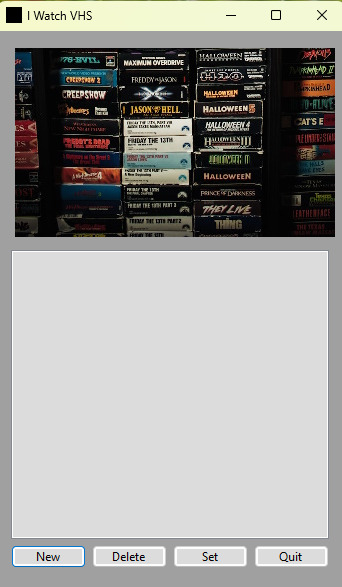
This is a program list. It is written with Visual Basic. In terms of practice with Visual Basic. I am going to practice part. And, that’s right! So, this is a right way to act! Program can add new cassette, delete. And all these things, are saving into the file. And, that’s all. Plus settings. Most simple. Select language. And that’s all.

For point of interest, there is little picture with cassette collection. And, it is about vhs cassettes soft. Add. Delete cassettes, which you have. And, manage this list. For your own interest! And, it is so cool to live and have some interests! So, you have a new cassette. Press new. And, write a cassette name. And, so you have update a list! And, main, all these things are written in a file. When you open program again, so all cassettes will be before your eyes. If some cassettes you enter in a list – you bring it to your friend or make a present! Well, maybe, you are so good and kind. So, select cassette in a list and press delete! And list will be updated again. And everything is written in a file.
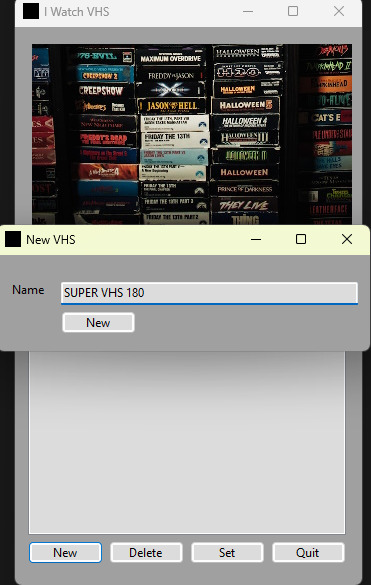
Interesting feature. You can, something like, copy file with program in different places. And, give a folder name, where you have exe file as you wish. And so, this way, - you can have lots of lists, if you need this! For example, create folder pack with name – cassette pack 1. And, copy program there. Later, create folder – cassette pack 2. And, copy program there. And, this way, you will have two lists. So, you can do, with genres. Or give a name as you want, this is example. So, cartoons, action movies, horrors, fairytales, as you want. It is simple example.
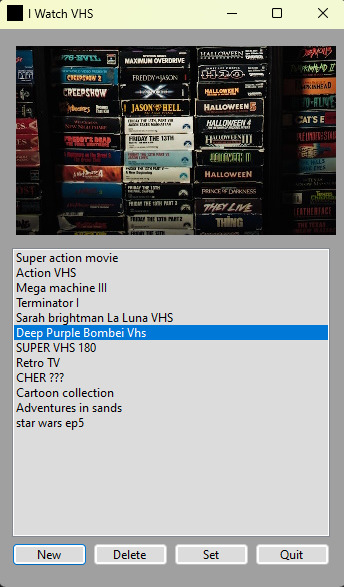
Program has most simple form. And that’s why program itself works now only with one file list. Well, for just having interest or to have fun – it is normal! So, now, this program is not overload with functions. And, simply, it is a list for interest. Add, delete. Everything saved. For interest – you launch program. And, there you have a picture with cassettes.
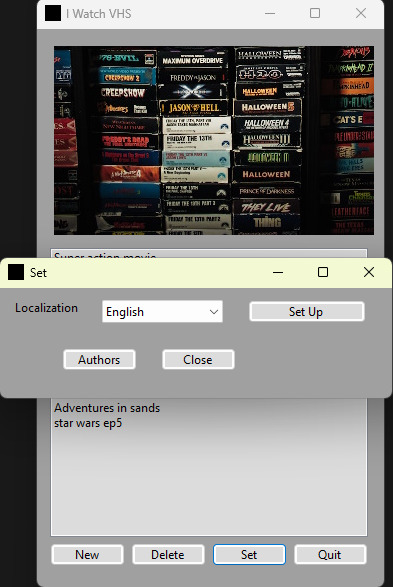
Look, photographer make a photo. Bruno Guerrero. I guess, he makes a photo of his own cassette collection. And, upload to network. Well, he is a cool guy! I am sure about this. And, you can have some points of interests! And, live an interesting life! To watch VHS cassettes in your weekend. And to manage this kind of little list!

File with list, it is simple text file. Where everything is in open form. You can see. But, with program, little program – it is more fun. And, yes, saying honest, there is no sort by alphabetical. Just as it goes. Something like, it is a heap of cassettes, that you have. So, this version is now. So, this way little program has a name – I watch Vhs. Such a development for point of interest! In weekend, you open and watch what do you have. What to watch, something cool to watch!
Make a selection – and put cassette in player. And whole hour - sit and watch! Later go to do something another! There are lots of stuff, recorded with cassettes. And music. And movies, of course. Some music concert, Sarah Brightman Eden, for example. Or Deep Purple band concert. I have these things! Or movies. Of course. So, here we have a big selection. Everyone has their own favorite movies. And movies, simple, that you add to your collection. To watch. Or something new. Which you have never seen before. Anyway, it is new thing. If you do not watch it.

Let`s, say, movie is from 80s. For example. And, if you do not watch it – so, it is, anyway, it is new item for you! So, here it is question, what do you have, and what to watch. So, it is rather a question about – point of interest with Vhs cassettes. Friday evening to sit and watch Vhs – excellent theme. At Saturday – to the countryside! Or, after the countryside, you are tired – and watch Vhs.

And, I heard a thing. I never try it by myself. And, I never have this kind in my hands. I am talking about, that some Vhs cassettes are recorded with only music. So, this means, without picture. I don’t know. This way, or static picture. Ort black background. So, they write music itself. And listen with Vhs player. So, it is also a way to use!
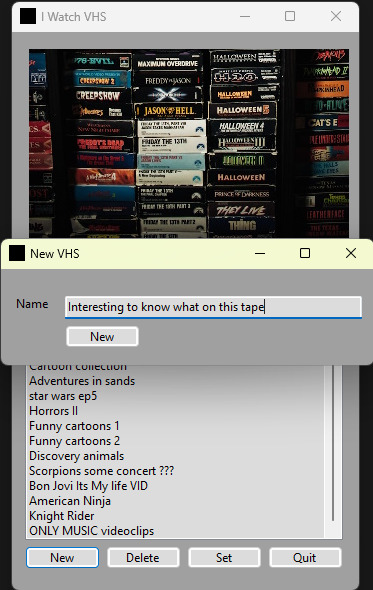
It is good to collect cassettes about points of interest. Video concerts with musicians. Video tapes with concerts. Cool theme. Or movies. Movies and cartoons – there are lots of them! Well, it is obvious idea, everyone knows that! So, that’s why, I think everyone knows about this! Main theme, vhs – it is movies and cartoon!
Well, there are lots of way to use. So, we have some result – I watch Vhs! Live with having some points of interest! And give a try this little soft!

Malenkiy soft. It is small little programs with Visual basic. This little program, by the way, will be at the very first release! And now there is nothing!
#i watch vhs#vhs#80s movies#application#soft#visual basic#small app#little soft#list#program#vhs cassette#manage collection#point of interest#tapes#music collection#video concerts catalog#catalog#easy catalog#simple list manage#lots of vhs#vhs fan#watch tv#crt tv#devlog
3 notes
·
View notes
Text
While Leo thought that there was a good deal of fun in tumblr adopting the stylistic rules of House of Leaves, even in posts not directly about the book, he thought that this could be extended further. For instance, the site could adopt the style of The Neverending Story and alternate between red texts when describing things that happen in the “main” level of the text while using green text to refer to a story-within-a-story. Perhaps clever expectation-reversal in color use could be employed to great effect; for example, by suggesting the difference between levels of story were more nebulous than could otherwise be communicated. Leo was sure there were fancy academic terms to describe these different levels more usefully, but he had never shown much interest in any literary field until his final years of education. He bemoaned taking only two courses in English, both of them too niche for much wider applicability and certainly no help in communicating his thoughts in a known framework. Frustrated, he turned back to his Simulatometer-9000. Plugging in the right parameters, he sat back, eagerly looking forwards to seeing the machine’s prediction for what such fontological plans would lead to.
And so the brave tumblr-user, penning his thoughts entirely in the shades of cheerful green and candy-red that the tumblr mobile app allowed, discovered to his dismay that his writings were not being interpreted as he anticipated. Rather than connecting his stylistic choice to The Neverending Story, the audience instead thought it all to be in reference to The Dread Work, which unbeknownst to many had itself made many seemingly random stylistic choices in order to echo, incorporate, and comment on Michael Ende’s work. Green was interpreted not with the land of Fantasia but with a saccharine fanartist, Red not with the real world but with a murderous villain. Confusingly, the color associations with these characters did not even appear to be consistent within the story. Nevertheless, the use of red and green served similar ends in Hussie’s odious compendium, coating the words of the two figures as they performed both as author figures and audience surrogates in a way that collapsed both the perceived difference between the two roles as well as the sets of behaviors they each represented.
But unfortunately for the brave tumblr-user, the associations these two Caliginous entities carried with them were not quite the same as the ones he intended, yet were similar enough that legible but unintended readings of his commentary were entirely possible. Suddenly the brave user’s thoughts on recursion in stories were being interpreted as commentaries on the author function, his thoughts on how to view a story in the context of its intertexts interpreted as musings on the consequences of reading a work through the lens of fandom.
Moreover, many people were unfamiliar both with The Neverending Story and Homestuck, only knowing that the latter made heavy use of brightly-colored text. Many thus scrolled past, assuming that the brave user was rp-ing characters they knew to avoid learning of. Others assumed that, much like many netizens who grew up on Hussie’s Scribblings adopted a “writing quirk,” the user was unthinkingly using an affectation in an annoying manner. The user fell to his knees, bemoaning his ill fortune, cursing the name of the one who made brightly-colored text as a formatting element played-out.
“Huh,” Leo said looking up from the simulation, “it looks like typing in that style wouldn’t work as well as I thought.” He rose, glad he had not wasted time pursuing his colorful plans as the brave user in his simulation had. Then the Minotaur got him.
62 notes
·
View notes
Text
it is funny how. just about every video talking about javascript arrays/objects/functions/what-have-you is likely to use the same analogy
"well, if a javascript object is like a car... the constructor is like a blueprint... and you can define what colour and model it is... and you can have an object array that is like a garage for your cars..."
"let's make an array of people, define a 'first name' and 'last name', then look! you can use a function inside the constructor to add the first and last name together and set it as the 'full name'-"
"to demonstrate this array function, LeT's StArT wItH a LiSt Of FrUiT, lEt'S hAvE a ShOpPiNg LiSt AnD tHe ArRaY iS lIkE a ShOpPiNg TrOlLeY!"
you can use arrays to hold information as in like. link directories. that's how my whole folder system is built, I don't need to manually add new URLs or anything because whenever I add a new subject tag, having it be part of that array means all the functions I set up will write it into the HTML automatically.
and yes, the archive entries themselves are their own array that I can filter and sort. I have a constructor as a base template for each entry, ensuring they each have: image sources (which are actually their own array inside the object, so I can add multiple), a date (which, if I'm not sure, setting the day and month to 0 and estimating the year will signal to the constructor to change it to something like "unknown, approx 2015" instead of an exact date), a description (which also gets formatted into html so if I want to say, add paragraphs, links or lists inside this variable I can totally do that), content/subject tags to make sure they get sorted into the right places and really just the "display" and "feature" flags which are ways of feeding data back to the CSS about how I want to display things and as a way of filtering particular pieces I like respectively.
you could use a javascript array to make a directory of comics and how many pages each comic has and what the sources are for each page and if it has bonus features or any other specs about how you want to display it and what it links up to.
you could program a cryptographic dial and program a function to assign different symbols to different letters of the alphabet depending on which position it's set at and if it's supposed to read clockwise, or counter clockwise, or alternating - you could have all of those as functions applying different rules in different circumstances.
you could have, fuck, I don't know, a program that alters what pronouns the user is referred to as based on settings they choose?? by having a little placeholder signalling what kind it is and using the string.replace function to switch it out?
I FEEL LIKE MAYBE YOU COULD USE AN EXAMPLE OF SOMETHING SOMEONE MIGHT WANT TO DO?
4 notes
·
View notes
Text
English - Final Essay (rough copy)
Hi!! So, I have an Essay due tomorrow for my English course and I need help. I was away sick for the entire week we were doing writing & peer review, and so I’ve been unable to get much done outside my (rather rushed) rough draft. I need to have this in, ideally, by tonight, and by tomorrow evening at the absolute latest. My grade in English is currently my worst and I cannot fail this course if I want to stay in my current program.
The essay is under the cut, it is supposed to be argumentative, there is no word limit but it’s supposed to be a 5 paragraph essay. Would anyone be able to give me some pointers to improve it? I’ve never written an argumentative essay before and the last time I properly wrote an essay was a year ago.

The Failings of the Hero’s Journey:
Why Joseph Cambells work is not as critical as it is made to seem
Joseph Cambell’s ‘The Hero’s Journey’, as well as the associated archetypes, are imperfect and outdated. Though we are taught the Hero’s Journey from elementary school through to highschool (and beyond if your English Lit. professor is particularly spiteful), we are not told to question its many failings, such as its limited applicability, inefficiency in classifying characters, and all-together blandness it brings to a story, and are often made to believe it is the end-all-be-all in determining the worth of a story within public academia.
The Hero’s journey, while applicable to some stories, is not applicable to all. It was based on historical epics and sagas, often which had little to no concept of the ‘anti-hero’ or characters that were morally grey, two concepts that are now beloved by readers across the globe. While it is a functioning tool to compare the Epic of Gilgamesh and Beowulf, both having similar story arcs and being in a similar epic style, it is a lot harder to use it to compare a novel like A Psalm for the Wild Built by Becky Chambers to Angie Thomas’s Concrete Rose, or to Xiran Jay Zhao’s Iron Widow series. These discrepancies don’t simply lie in the realms of modern literature, the concept of The Monomyth, as outlined in Joseph Cambell’s ‘The Hero with a Thousand Faces’ cherry-picks ideas from individual legends while ignoring outliers; it is a lot harder to set the creation story of the Raven and the Clam from Haida mythos to the tune of the hero’s journey then a multi-year, inscribed epic, but it is a legend nonetheless. Should it not, then, fall into the Monomyth? According to Joseph Campbell, the format should still apply, yet one would have to twist the tale into something near unrecognizable for it to fit into such a rigid mold.
Cambell’s formula is not just narrow in scope, but inefficient. It wastes time and energy squashing characters and plots into neat boxes with little room for change, when better and more in-depth analyses could be made in similar time frames if one were to forgo using The Hero’s Journey entirely. While one could spend hours debating the role of any specific character and which of the categories illustrated in Cambell’s work they best fall into, one could just as easily list and map their behaviours, internal dialogue, and motivations and come out with a much more detailed picture of both the character and how they affect the story. In terms of plot, The Hero’s Journey work states clearly that each and every story holds the same path, be it for a specific character or the overarching plot, but this is simply untrue. Many works often cited as the purest examples of the Monomyth (Tolkein’s works, and the first 2 Star Wars trilogies to name a few of the more famous examples) still do not fall completely into the pattern of The Hero’s Journey. One could argue that, while the original format of the Monomyth does not apply to every character and plot, it is still a good foundation for many classics and can be rearranged to fit many other tales more comfortably. The former point is one I will not argue, and is a fair reason to still teach it in schools, the second, however, holds issue: you cannot rearrange the steps of The Hero’s Journey, that is its very point. It says that every story follows, give or take, these exact same steps in the exact same order, hence the ‘mono’ in monomyth. It makes sense to cut up and rearrange the steps, it helps it fit more stories and, for middle grades, it is a good way to show the complexities of ‘traditional’ stories, however, in changing it it is no longer Joseph Campbell’s interpretation of myth that one is using, rather a new system based upon it. In this way Cambell’s archetypes and Monomyth cannot be considered a truly good tool, as one has to break and rearrange it to give it any semblance of application to the vast majority of modern, and even classic, literature.
The Monomyth, and ensuing archetypes, were taught to me throughout elementary, middle, and now high school. I don’t believe I can think of a single English course that did not, in some way, reference Cambell. Not only is this repetitive, but it also risks boredom in classes that otherwise are rather engaging. That is not to say that it should not be taught in schools, but constantly hearing it may lead to both a subconscious bias towards stories that follow this format (something harmful in later studies of folklore, poetry, and many nonlinear works), as well as creating a distaste for one's own creativity, cultivated by the repeated use of The Hero’s Journey as grading and assignment criteria. I, for one, have certainly fallen into the trap of the latter. This is incredibly relevant, given the recent decline in literacy amongst school-age children and adolescents. While one should not blame modern English curriculums alone for these plummeting statistics, having little change in lessons from elementary school through high school, and having to do similar, if not the same, assignments every year is sure to drive those who are already underperforming and/or unmotivated for English, or any humanities course for that matter, to try less and be less engaged with the course and it’s material.
None of this is to say that Joseph Cambell’s work is not a tool to be taught in schools, nor that it cannot be used in literary analysis, simply that you cannot expect the work of a professor of Medieval Literature that was published in 1949 to be able to apply to the vast range of stories that are available to us and have been created throughout the history sapiens.
#chaotic academia#dark academia#light academia#studyblr#writeblr#essay writing#essay review#school help#help plssssssss#i also don’t know how to do in-text citations but I’ll figure it out
4 notes
·
View notes
Note
hi!! thought i'd direct my ask here since it's writing related -> how did you set up the google sheets to set and track word goals?? i opened up a sheets but it's a bit intimidating ;;
i'm guessing you do Insert>function>??? one of those? but idk which
there are a lot of different ways!! some basics to know:
the main functions i may use here are =SUM, =AVERAGE, =COUNTIF then follow the formula outline
more frequently i stick = in the formula box then select cells (or tab you want then its cells) with my mouse (a quicker way than typing cell or tab names)
but you can also limit cells usage by editing formulas directly in the cell you want to see the = in (like, you can have a cell with "=2+2" or a cell with "=A1+A2" with the numbers in them. both cells will have the same total calculated by the = but the formula bar will look different). Data Managers™️ recommend keep everything visible in cells, but we aint publishing this so do what you want
i also use cell formatting as % or date or whatever for less formula writing (% for example, i otherwise gotta do whatever math is needed for calculating that when i can just do the basics then ask it to do the rest AND it adds a % sign for me)
now let me go from least to most complicated set-up at start:
1. Total at Bottom
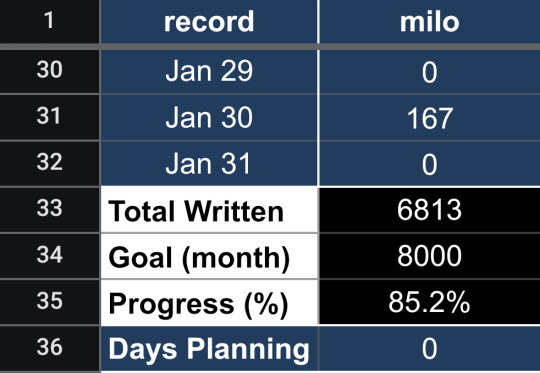
i got this settup to track multiple people at once, but you can keep the record column as Day 1, Day 2, etc and change the name columns to be months. Formulas:
row 33 Total Written =SUM(B2:B32) (alter the letter and number depending on column and days in month)
row 34 Goal (month) [free write #]
row 35 Progress (%) =B33/B34 , aka =[Total Written cell/Goal (month cell] format as %
row 36 Days Planning =COUNTIF(B2:B32, "planning") (or whatever specific word you want)
you can also have a year total somewhere, which you can see examples of how to in the last method
2. Weekly Goal
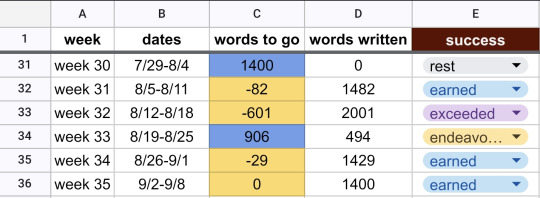
there's more manual in this so far which makes it easier to setup, harder to keep up on. columns week, dates, and words written are write-in (the last which i may =#+#+# throughout), but formulas:
column c words to go =1400-D31, aka =[word count goal]-[relevant "words written" cell]. conditional formatting (which i may swap the colors):
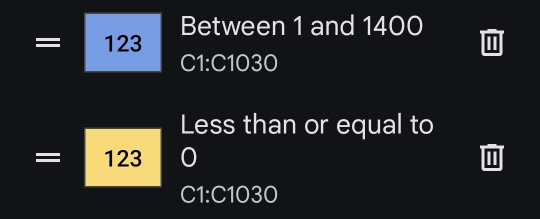
column e success is a drop-down menu which i forget how to create every time... look up "how to create drop-down menu in [spreadsheet program of choice]". i manually select the success based on vibes: earned, endeavored, exceeded, and resting
3. Detailed Year
there are two tabs here with more initial setup but less to manage later. they read from each other (what the ! does in a formula). starting with the daily data tab:

column date is formatted for calendar
column type is formatted with a drop-down menu, which the thought is to later make a pivot table counting the frequency of write, edit, edit+write, and daydreaming.
column word count is a manual input with conditional formatting
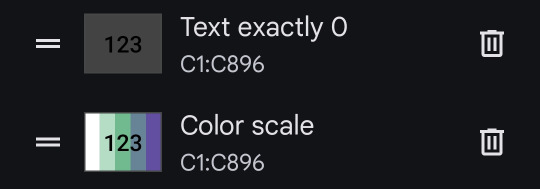
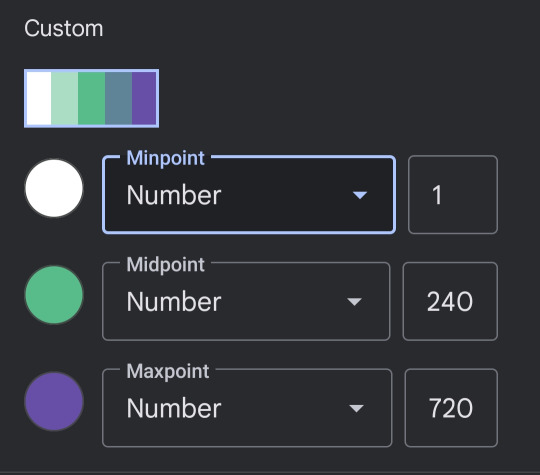
then the year tracking tab:
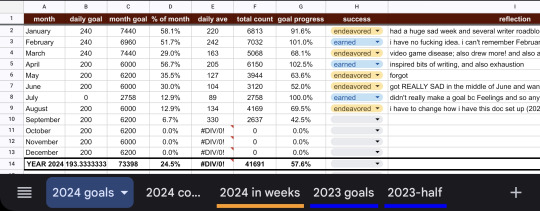
the free write-in columns are month, daily goal, and reflection. the column success is a drop-down i manually select at end. everything else has formulas:
column c month goal =[daily goal cell]*[# days of that month]
column d % of month will look like =(COUNTIF('2024 count'!C246:C275, ">0"))/30 , aka (COUNTIF('[name of daily data tab]'![relevant cell range from tab],">0"))/[days of month] formatted as %
column e daily ave is =AVERAGE(('[name of daily data tab]'![relevant cell range])
column f total count is =SUM('[name of daily data tab]'![relevant cell range]
column g goal progress is =[total count cell]/[month goal cell] formatted as %
the total row at the bottom goes like
daily goal =AVERAGE([above cells])
month goal =SUM([above cells])
% of month =AVERAGE([above cells])
daily ave =AVERAGE([above cells])
total count =SUM([above cells])
goal progress =AVERAGE([above cells])
yea that's about it
#i struggle with math so much that i took what i learned in my college classes on spreadsheets and sprinted alxlshckx#an organized calculator just for me that i can have it automatically color code?? Yes Pls#word count progress#asks#the weekly goal one is still a wip. hence why it's clunkier
6 notes
·
View notes
Note
Since you do a lot of text color formatting for Early June(though I guess I'm assuming that you don't have someone else help with that), I was wondering if you could give some tips on making that more bearable?
I'm doing a similar thing, and it takes me a really long time to format everything, especially in scenes that function like pesterlogs where characters talk back and forth and require a whole span class statement with each new line. Is it just one of those things where it's like "yeah it sucks but you kinda just have to deal with it," or do you have ways to make it easier?
Oh totally! I do all the formatting myself in AO3, and at this point I've honed my technique to the point where I can get formatting done fairly quickly.
First things first: Find and Replace is your friend always. I use this extension for Firefox which allows me to save favorite replacement settings, and it's very reliable.
Basically, after you're done writing what you want to write in another program, go to the HTML section in AO3 and paste your writing there.
After that, I always recommend previewing the plain text before further editing. I find that editing without previewing can eliminate things like paragraph breaks which will be a nightmare.
Dialogue tags are pretty much universally the same in Homestuck, making them an ideal vector for Find and Replace, so after you write, say:
ROSE: This is an example sentence.
You can just go into your Find and Replace tool, replace all instances of
ROSE:
with
<span class="rose">ROSE:
And then you've just tagged every line of dialogue by Rose! Repeat for all the other characters you have in the chapter. And if you save each replacement setting, upon opening a new chapter you can get a character's dialogue colored in seconds.
Now, be warned: AO3 does you the kindness of placing all the </span>s at the end of the paragraph. The upside to this is that you don't need to actually end your span classes as long as the entire paragraph is properly formatted dialogue, though it will look ugly as hell in the back end and may glitch out. But this DOES make it harder to catch when/if you forgot a character or misspelled their name, so I'd always recommend proofreading a couple times, though to be fair that goes for all writing.
For narration paragraphs I just manually copy and paste the p class.
There's also lots of little quirks and complications that make it difficult, and sometimes you're just gonna have to do it manually. Davepeta's two-toned text combined with a variable quirk in the B33 and the B;33 and the B33c sense means you just gotta do it by hand, but this should help with the vast majority of formatting issues.
I know there are also some external tools for this sort of thing that do the work for you, I'm sure someone will link them in the comments, but this is just how I do things. Hope this helps!
6 notes
·
View notes
Text
Inform Basics: practice with tables
Tables can be intimidating, but they are great for handling complex situations with text. Since writing and printing text is my whole jam, I've pushed myself to use tables as much as possible. My first ever table turned out to be the central tracking system for magic in Repeat the Ending!
I think I had some beginner's luck there--I never needed to change/fix it later. We'll use it as a model for the next few posts. I've made a couple of things nicer for this discussion, but the core functionality is unchanged.
Let's Make a Table!
A table, as a lot of you probably know, is a way to store and present information. It is a grid organized by rows and columns. If you've ever seen a spreadsheet program like Excel, you can visualize the way rows and columns can be used to arrange information sensibly.
In Inform 7, a table has very specific formatting conventions that must be followed:
It begins with the text "table of [insert your title here]" alone on a single line of code.
On the very next line, the names of the columns must be typed and separated by a single press of the TAB key.
The next line(s) contain(s) data. Once again, columns are separated by the TAB key. Note that actual empty entries are not permitted. Instead, populate so-called "blank" fields with two hyphen characters (without quotation marks).
Here's an image of a very paired-back version of the table from RTE:

In some cases, we need to tell Inform 7 what a column of data is. More on this next time. For now, just be aware that I've got this in my code to explain what the first column, "siphontype," contains.
siphontype is a kind of value. the siphontypes are defined by the table of diagnoses.
There's no magic to any of these names. They're just what seemed right at the time.
Some simple applications
What can we do with it? Without getting up to anything fancy, we can count the rows. Inform 7 will count almost anything if you use the phrase "number of [almost anything with a numbered quantity]". I'll make a custom action, frobbing, for these experiments.
frobbing is an action applying to nothing. understand "frob" as frobbing. carry out frobbing: say "The number of rows in the table of diagnoses is [number of rows in the table of diagnoses]."
Output:
>frob The number of rows in the table of diagnoses is 3.
We can also dump the entire contents of the table. "Repeat through," which we've used on lists, can also be used to apply an operation/action/etc. to multiple rows in a table.
repeat through the table of diagnoses: say "[siphontype entry]: [diagstring entry]"
OK. Since "siphontype" and "diagstring" are column names, Inform 7 will walk through each row, printing the relevant entries.
What does that look like?
>frob The number of rows in the table of diagnoses is 3. TInert: At the moment, I am not empowered by any sort of entropic magic.TPsychic: [REDACTED]TLucky: Feeling lucky?
Yikes. That's pretty ugly. Let's get that text cleaned up.
carry out frobbing: say "[bold type]The number of rows in the table of diagnoses is [number of rows in the table of diagnoses].[roman type][paragraph break]"; repeat through the table of diagnoses: say "[siphontype entry]: [diagstring entry][line break]"
The main features here are bold text for the first line, a blank line between the bold text and the table dump, and line breaks after every printed row. It winds up looking like this:
The number of rows in the table of diagnoses is 3.
TInert: At the moment, I am not empowered by any sort of entropic magic. TPsychic: [REDACTED] TLucky: Feeling lucky?
I think that's enough for today! Next time, we'll dig deeper into tables, using the same bit from RTE as an example. As always, feel free to AMA
Code used in this post:
#interactive fiction#inform 7#parser#i7 for beginners#i am not a programmer irl#tables#repeat the ending#AMA
6 notes
·
View notes
Text
The Parliament Fart of 1607, or Satire and Respectability
On the 4th March, 1607, just after being read a message from the Lords, one of the younger members of the English Parliament, Henry Ludlow, farted somewhat loudly, enough that everyone heard it. This event was noted enough that it is remembered even now as the Parliament Fart of 1607.
Farting was common in humour throughout the Medieval and Early Modern periods, as broad humour involving sexuality and scatology was quite widespread, however in-person farting was considered indiscreet for a gentleman. Cleanliness and control of one's bodily functions was associated with sophistication, and farting could be particularly awkward in a society that associated bad smells with infection (see miasma theory). So this was the kind of thing that might damage your reputation, even your career, particularly at a public event. But, in the end, Henry Ludlow escaped relatively unscathed, he had other scandals given his quarrelsome nature, so perhaps that distracted people.
What did emerge from this moment however was a series of manuscript poems satirising the event. Manuscript, hand-writing, was the standard form for controversial writings because it couldn't be traced back to a specific printing-press, as seen similarly in the "libels" of the time where people would mock recently-deceased political figures. This one was written many times in different ways, and continued to be reimagined as late as the 1660's early Restoration.
All versions start with the fart, often described him similar wordings, and then follow a format of rhyming couplets with various named members standing up to respond to the fart. There's a bit of mischief here in how the members, speaking largely like they would with any other parliamentary business, attempt to keep a sense of dignity in their responses.
One example has the first sentences as:
"Downe came grave auntient Sr John Crooke And redd his message in his booke. Fearie well, quoth Sr William Morris, Soe: But Henry Ludlowes Tayle cry’d Noe. Up starts one fuller of deuotion Then Eloquence; and said A very ill motion Not soe neither quoth Sr Henry Jenkin The Motion was good; but for the stincking Well quoth Sr Henry Poole it was a bold tricke To Fart in the nose of the bodie pollitique." (Bodleian Library manuscript, Malone 23)
You can get a sense of the style of these poems from that. At the time of the original incident, the parliament was debating the naturalisations of the Scots after the Union of the Crowns under James VI and I.
James was originally a Scottish king before English, somewhat subverting the original English desire to conquer Scotland, which unsurprisingly some people weren't very happy about, the Gunpowder Plotters themselves where partially motivated by anti-Scottish xenophobia. His mother was Mary Queen of Scots (of head-losing fame) but he was separated from her long before she died and raised by his Protestant relatives. Because of their descent from the line of Henry VII's eldest daughter Margaret, many considered James and his mother as the primary heirs to the throne, so his Protestantism cleared many of the barriers for his acceptance his mother had faced. Though it's unclear whether Elizabeth ever really accepted James as heir, he was increasingly treated as de-facto heir in the later years of her reign.
Because James inherited the English crown separately (and associated crown of Ireland, English dominion over Wales and not-yet-forgotten claim to the throne of France) it remained entirely independent from and distinct to his kingdom of Scotland. James disliked the idea of holding two crowns at the same time when the system were quite different, so he became the first person to propose the political idea of Great Britain, which would not become a reality until the reign of his great-grandaughter Anne in 1707. While he could only use the title Britain in prerogative matters, things the King could do unilaterally, since he could not convince parliament to accept it, James wanted parliament to at least recognise Scottish subjects born after the union, "post nati", to have natural rights at English subjects.
Naturally, this was one of the subjects referenced in the first Parliament Fart Poems, along with other contemporary topics like freedom of speech and royal finances. But the different versions changed significantly over time. They didn't just fiddle with wordings, they also adapted to reference different issues. Later in James' reign there was the Overbury Scandal, a political murder, and the 1624 Monopolies Bill, on a form of profiteering patenting, later versions written during the 1640's took on the context of the intense parliamentary debate at that time leading up to the civil war. And when it re-appeared in the Restoration, it was used to mock parliament from a Royalist perspective, despite most previous uses being more pro-parliament.
Of course, at the end of the day, the Parliament Fart Poem wasn't just about politics or any other serious topic, it was also play, it was funny, it was fun to write neat little rhyming couplets. It appealed to a taste for irreverent crude humour that was popular at the time even in higher circles. You can see a similar sense of humour in many of Shakespeare's play, so it was far from alone in mixing the high and the low, that was what made such pieces appealing to a relatively wide audience. They weren't too snobbish or narrowly airy. A lot of the classic literature from the Medieval and Early Modern periods had crude humourous moments, Chaucer's Canterbury Tales did too, and that was commonly reprinted in this period as a kind of vintage classic.
Perhaps in the modern day we could also use a moment to laugh at a fart, we'd be in good company.
4 notes
·
View notes
Text
Storing images in mySql DB - explanation + Uploadthing example/tutorial
(Scroll down for an uploadthing with custom components tutorial)
My latest project is a photo editing web application (Next.js) so I needed to figure out how to best store images to my database. MySql databases cannot store files directly, though they can store them as blobs (binary large objects). Another way is to store images on a filesystem (e.g. Amazon S3) separate from your database, and then just store the URL path in your db.
Why didn't I choose to store images with blobs?
Well, I've seen a lot of discussions on the internet whether it is better to store images as blobs in your database, or to have them on a filesystem. In short, storing images as blobs is a good choice if you are storing small images and a smaller amount of images. It is safer than storing them in a separate filesystem since databases can be backed up more easily and since everything is in the same database, the integrity of the data is secured by the database itself (for example if you delete an image from a filesystem, your database will not know since it only holds a path of the image). But I ultimately chose uploading images on a filesystem because I wanted to store high quality images without worrying about performance or database constraints. MySql has a variety of constraints for data sizes which I would have to override and operations with blobs are harder/more costly for the database.
Was it hard to set up?
Apparently, hosting images on a separate filesystem is kinda complicated? Like with S3? Or so I've heard, never tried to do it myself XD BECAUSE RECENTLY ANOTHER EASIER SOLUTION FOR IT WAS PUBLISHED LOL. It's called uploadthing!!!
What is uploadthing and how to use it?
Uploadthing has it's own server API on which you (client) post your file. The file is then sent to S3 to get stored, and after it is stored S3 returns file's URL, which then goes trough uploadthing servers back to the client. After that you can store that URL to your own database.

Here is the graph I vividly remember taking from uploadthing github about a month ago, but can't find on there now XD It's just a graphic version of my basic explanation above.
The setup is very easy, you can just follow the docs which are very straightforward and easy to follow, except for one detail. They show you how to set up uploadthing with uploadthing's own frontend components like <UploadButton>. Since I already made my own custom components, I needed to add a few more lines of code to implement it.
Uploadthing for custom components tutorial
1. Imports
You will need to add an additional import generateReactHelpers (so you can use uploadthing functions without uploadthing components) and call it as shown below
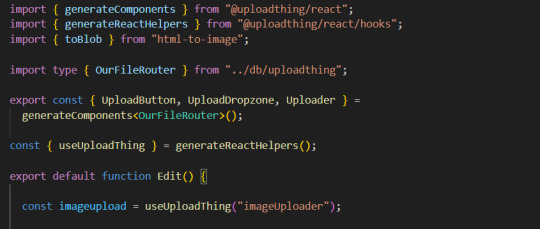
2. For this example I wanted to save an edited image after clicking on the save button.
In this case, before calling the uploadthing API, I had to create a file and a blob (not to be confused with mySql blob) because it is actually an edited picture taken from canvas, not just an uploaded picture, therefore it's missing some info an uploaded image would usually have (name, format etc.). If you are storing an uploaded/already existing picture, this step is unnecessary. After uploading the file to uploadthing's API, I get it's returned URL and send it to my database.

You can find the entire project here. It also has an example of uploading multiple files in pages/create.tsx
I'm still learning about backend so any advice would be appreciated. Writing about this actually reminded me of how much I'm interested in learning about backend optimization c: Also I hope the post is not too hard to follow, it was really hard to condense all of this information into one post ;_;
#codeblr#studyblr#webdevelopment#backend#nextjs#mysql#database#nodejs#programming#progblr#uploadthing
4 notes
·
View notes
Text
I can speak to this as a teacher who tries to train my middle school students to write to us semi-professionally. We try to prepare them to write to strangers, prospective employers, admin at different schools, or even just send semi-polite messages to each other, and it is not easy to do!
They don't like to capitalize, not even the first and last letters of their own names, and then trying to get to an understanding of how/why we should be polite when writing to strangers is another hurdle, but most of them get there in the end and are able to use the simple format above -- greeting, body, closing, signature -- with a little practice.
I'm a stickler about capitalization and I explain it like this: capitalization, especially in names, shows respect to the recipient, and using capitals in your own name shows that you respect yourself and take the interaction seriously.
That response above about a full paragraph in the subject line is something I see every year without fail, by the way, and it's frustrating. I tell them that the subject line shouldn't be blank, and to think of the subject as the title of their message. It should be short and sweet, 3-4 words maximum.
My students are young kids who just don't have experience with email even if they text or use snapchat or other social media, and I find that providing as must context as possible, along with multiple examples of how an email should look and what they should avoid, does help, but it's important for them to be able to practice this skill before they have to do it for real and inevitably fail in a setting where there are negative consequences for failure.
Very much agree that saying "just do it, it's not hard" is not going to help anyone regardless of age if they don't have experience sending professional email, or if email isn't accessible to them without modifications.
Keeping in mind that we use gmail, here are some things that help my students:
Exemplars as above
Speech-to-text as an option, especially for longer messages
Text-to-speech to listen to a message before sending
Practice using sentence frames for message body *and* subject line
Set up a signature (kids like this part)
Set up message templates (same function as sentence frames)
Use additional in-browser assistive tech like Read&Write (not free but many organizations, including schools, either subscribe to it or will pay for it if you ask)
For teachers: have your students send you a correctly formatted email as an exit ticket occasionally. The first few times I do this, and I don't do it too often, I make it easier by sending the class a message and their reply has to answer a question (single complete sentence with correct spelling and punctuation) *and* their reply must be formatted as a professional email. Later they have to compose a message/exit ticket and I reply. I've had them write to their elementary school teachers with me cc'd and that's a fun activity too, and they can observe how we (the teachers) reply to each other as part of a thread, which provides more and varied examples of correct formatting in context.
I try to make it fun for kids because they're bored by this stuff, and sometimes I lose them if they know they have to write a single sentence, but it always gets better with practice. It's also important to note that following some formatting rules makes our communication more accessible too.
not to sound like a boomer, but I need some people to learn how to write emails in a semi-professional (at the very least) format so you're not cold emailing a business/potential employer/any other stranger about formal matters in the exact same way you'd DM a close friend on instagram
the formality/language can loosen up in the email chain once you've established a rapport and you match the other person if they're being less formal, but please don't have the very first email you send a stranger be written in all lowercase ultra-casual sms slang with no greeting or signature and a billion emojis
42K notes
·
View notes
Text
2.The Art of Integration: The Last of Us Part II
Video games have evolved into a powerful art form, with many games embodying the principles of gesamtkunstwerk or ‘total artwork.’ Seamlessly blending story, graphics, sound design, and gameplay to deliver an emotionally compelling experience, The Last of Us Part II (2020) by Naughty Dog is a perfect example of all these components working together. This blog explores how The Last of Us Part II functions as a gesamtkunstwerk and how it uses the specific medium of video games to create work with extraordinary impact.
Medium Specificity in The Last of Us Part II
Medium specificity emphasizes the unique characteristics of a particular medium and determines how creators express themselves (Maras and Sutton, 2000). As a form of communication, video games allow players to engage with stories in ways not possible in other art forms.
The interactions in The Last of Us Part II add emotional weight to the story. Players control both Ellie and Abby, often making morally ambiguous decisions. Combined with the interactive nature of the game, these narrative structures immerse the player in the complex moral dilemmas of the story. For example, in key moments of battle, players are forced to confront their opponents’ humanity, creating an emotional resonance that would be lost in a non-interactive format.
If this story had been told in a movie or a novel, it wouldn’t have the same sense of communication that defines the game. The ability to control the characters and see the immediate consequences of decisions is key to the story’s immersive and emotional depth.
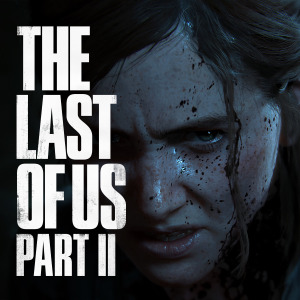
Gesamtkunstwerk: An Integrated Vision of Art
Gesamtkunstwerk combines various forms of art into a unified whole (Seiferle, 2023). The Last of Us Part II exemplifies this concept by combining visual art, sound, gameplay, and storytelling into one cohesive experience.
The story is deep: The story of The Last of Us Part II is a cycle of revenge, forgiveness, and violence. Its non-linear narrative, rich character development, and dual perspective make for a deep emotional experience. Naughty Dog's writing pushes the boundaries of video game history, providing moments that challenge players to consider choices and prejudices.

Visual perfection: The game’s visuals are stunningly realistic, with a wide variety of environments, ranging from urban wastelands to lush deserts. Naughty Dog used advanced motion capture technology to bring characters to life, capturing subtle expressions of raw emotion.

Sound design and music: Gustavo Santaolalla’s haunting music and careful sound design enhance the emotional impact of the game. The contrast between the peaceful sounds of nature and the intense battle scenes immerses the player in the game world.

(Gustavo's name and likeness is modelled after Gustavo Santaolalla, who composed the music for both The Last of Us and The Last of Us Part II.As noted by The Last of Us Wiki (2021), Gustavo plays an important role in the series.)
Game mechanics: The game is deeply connected to the story. Players must steal, fight, and explore—actions that reinforce the themes of survival, revenge, and redemption. For example, Ellie’s use of makeshift weapons and guerrilla tactics conveys her desperation, while Abby’s strength-based combat highlights her resilience.
Real-Life Parallels: Technology and Platforms
Naughty Dog developed The Last of Us Part II for the PlayStation 4, using the platform’s hardware to deliver superior graphics and smooth gameplay. The studio used advanced graphic techniques and rendering to create realistic characters and environments.
If the play had been adapted into a film, it would have lost much of its impact. The interactivity of the game, allowing players to experience the emotional journeys of the characters, is central to its story. While a movie can depict a story, it would lack the personal connection that game interaction creates.


According to Eurogamer (2024), the PS5 remaster of The Last of Us Part 2 offers significant technical improvements. Conclusion: The Last of Us Part II is a prime example of how video games can act as a gesamtkunstwerk, combining art forms into a cohesive experience. Its use of medium specificity highlights the unique ability of video games to convey emotional and immersive information. With the strength of its form, this game transcends the boundaries of traditional art, proving that video games are a legitimate and enjoyable form of art.
References:
Maras, S. and Sutton, D. (2000). ‘Medium Specificity Re-visited’. Convergence, 6(2), pp. 98–113. doi: 0.1177/135485650000600207. Available at:https://www.researchgate.net/publication/240730000_Medium_Specificity_Re-visited [Accessed: 10 October 2024].
Naughty Dog (2020). The Last of Us Part II. [Video Game]. Sony Interactive Entertainment.Available at: https://www.naughtydog.com/ [Accessed: 10 October 2024].
Santaolalla, G. (2020). The Last of Us Part II Original Soundtrack. [Music]. Sony Interactive Entertainment. https://www.naughtydog.com/ [Accessed: 11 October 2024].
Seiferle, R. (2023). ‘Gesamtkunstwerk Definition Overview and Analysis’. The Art Story. Available at: https://www.theartstory.org/definition/gesamtkunstwerk/ [Accessed: 11 October 2024].
Wikipedia contributors (2024). The Last of Us Part II. Available at: https://en.wikipedia.org/wiki/The_Last_of_Us_Part_II [Accessed: 11October 2024].
The Last of Us Wiki. (2021). Gustavo. The Last of Us Wiki. Available at: https://thelastofus.fandom.com/wiki/Gustavo [Accessed 13Oct. 2024].
Eurogamer. (2024). The Last of Us Part 2 Remastered PS5 tech analysis. Eurogamer. Available at: https://www.eurogamer.net/digitalfoundry-2024-the-last-of-us-part-2-remastered-ps5-tech-analysis [Accessed 13 Oct. 2024].
#Source and Significance#Medium specificity in the digital age#last of us 2#theory#gameplay#video games#art#game#hertfordshire#beingmughal#anime#story#the last of us#game art
0 notes